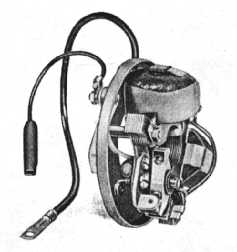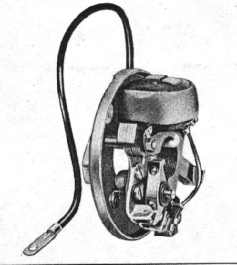The WIPAC "Series NINETY" magneto is a flywheel
Ignition Generator, approximately 4 ins. in diameter and
weighing about 30 ozs. yet capable of producing 9,000 volts
at 350 r.p.m. It is suitable for engines up to 100 c.c. When
employed to produce a current for ignition only the type
number of the magneto is prefixed with the letter I. Thus:
I.1263. When employed to give ignition and lighting currents,
the letters IG prefix the type number. Thus: IG.1184.
THE PARTS OF A WIPAC "NINETY"
MAGNETO
There are only two main parts in this type of magneto.
One is the flywheel and the other is the stator plate. The
flywheel contains permanent magnets but due to its design
and construction a " Keeper Ring" is NOT necessary when
removing it from the stator plate. (This feature applies to all
WIPAC built magnetos.)
The stator plate contains a laminated core with ignition
coil (and a smaller coil for lighting if it is an " IG " unit),
condenser and contact breaker set. The cam which operates
the contact breaker set is attached to the engine crankshaft.
The stator plate is held stationary in relation to the engine
whilst the flywheel revolves around it.
The magneto is highly efficient and requires very little
attention in normal use. It is designed to give a powerful and
stable spark over a very wide range of speeds. A spark
performance of 9,000 volts at 350 r.p.m. rising to 12,000 volts
at 6,000 r.p.m. is obtained, with a large enough air gap main-
tained between the flywheel and stator to ensure a trouble-free
system. Frequent adjustment of the contacts is unnecessary
and a fair tolerance for the accuracy of their setting has been
allowed for.
"Ninety" magnetos fitted with a lighting coil will give
an exceptional and reliable light at low speed without flicker
yet will not seriously overload the bulbs if the engine runs at
extremely high speeds. Two standard lighting coils are em-
ployed, either a 7.8 watt output or a 9 watt output, depending
on the Engine Manufacturer's specification.
Flywheels are also made in two types. Finned or Plain.

Series 90 Stator Plate with H.T. and Lighting Coils
The finned type is employed with a cowl to give the engine
extra cooling air and is usually fitted to stationary industrial
engines. The plain flywheel has large slots in its face so that
the contact breaker points can be adjusted without removing
the flywheel. These flywheels are drilled and tapped around
the boss for attaching a flywheel extractor tool which is made
and supplied by WIPAC.
RUNNING MAINTENANCE
Occasionally
Check the contact points for cleanliness. (It is impossible
to lay down a definite time for doing this as conditions will
vary, e.g. the "points" will need watching more during a
long spell of muddy weather.)
If dirty, clean by inserting a piece of tissue paper between
the contacts and withdrawing, while in the closed position.
Do not allow the engine to run with.oil or petrol on the contacts
or they will burn and turn black. If this has happened, polish
with extra fine emery cloth.
Every 5,000 miles
1. Check contact points for gap setting. If adjustment is
necessary see "Adjustment of Breaker Points" below.
2. Re-lubricate the cam oil pad. To do this, slide the pad
out from its holder and squeeze and work into it a Summer
grade of motor transmission grease. Do not use oil.
3. Check the plug lead for chafing and see that the terminal
at the spark plug end of the lead is gripping tightly.
GENERAL MAINTENANCE
Checking magneto for spark
If the engine fails to start and there is indication that the
magneto is at fault:-
A. Disconnect H.T. lead from the spark plug and hold it
about 3/16" away from some unpainted portion of the frame
or engine. Rotate the engine and a spark should jump
this gap.
B. If no spark is visible:-
1. Check H.T. lead for continuity.
2. Make sure there are no metallic particles inside the
unit.

Series 90 Stator Plate with H.T. Coil only
 COMPLETE SERVICE INSTRUCTIONS
COMPLETE SERVICE INSTRUCTIONS